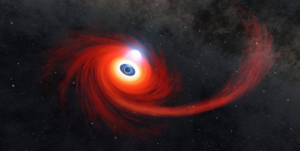The Event Horizon Telescope, which brought us the first-ever image of a black hole and the first view of the supermassive black hole at the center of our galaxy, has inspected a much brighter target: a quasar. Quasars are extremely luminous objects that are powered by matter spiraling into huge black holes. These active galactic nuclei, as they’re called, spew electromagnetic radiation out into space—and the EHT team might have just peered inside one.
A global collaboration of scientists studied NRAO 530, a quasar about 7.5 billion light-years away, which, according to the team, is the most distant object yet imaged with the Event Horizon Telescope. Using the telescope array, the researchers, led by Svetlana Jorstad from Boston University’s Institute of Astrophysical Research, observed some of the quasar’s features. Specifically, they imaged a jet of radio-wavelength radiation that spans 1.7 light-years.
The research team also observed the quasar’s core, where the jet begins, and two mysterious structures within the core that the scientists couldn’t see properly with the telescope’s current capabilities. The jet also features a magnetic field that likely has a helical pattern to it, or some kind of curvature, according the team’s measurements of the light emitted from the jet.
“The outermost feature has a particularly high degree of linear polarization, suggestive of a very well ordered magnetic field,” said Jorstad in a statement.
Step towards quantum computers “which could break the internet”
One of the key methods Jorstad and the research team used to image the quasar is called Very Long Baseline Interferometry, or VLBI. Telescopes spread across the planet in an array, like the ones that make up the Event Horizon Telescope, can all capture radio signals from the same astronomical source. Astronomers using a VLBI methodology can then collect these different data points and account for any difference in detection time (data from a source might be collected at one telescope slightly before its collected at another telescope) in order to build a detailed image of the target.
Astrophysicists are learning more about quasars thanks to new observing tech like EHT and the recently launched Webb Space Telescope. Images from Webb released last fall revealed a polychrome quasar whose galaxy is interacting with three others in a galactic “knot.” And back in 2020, the Hubble Space Telescope observed quasar “tsunamis,” which researchers think could be powerful enough to shut off galaxy formation.
Source: Gizmodo
Ask me anything
Explore related questions





